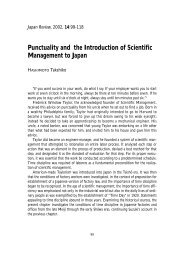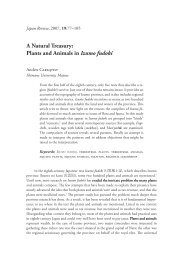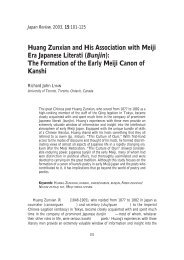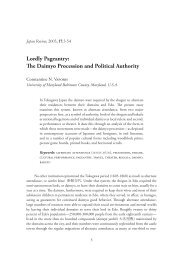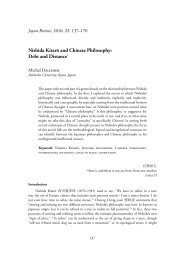Meiji shinkyoku - 国際日本文化研究センター
Meiji shinkyoku - 国際日本文化研究センター
Meiji shinkyoku - 国際日本文化研究センター
You also want an ePaper? Increase the reach of your titles
YUMPU automatically turns print PDFs into web optimized ePapers that Google loves.
104 Philip Flavin<br />
Th e school of performance to which I belong, the Seiha Hōgakukai 正派邦楽会, has published<br />
no more than fi fteen scores. Other publishing companies have released the scores for another<br />
twenty or more pieces; most of these, however, are seldom performed. Indeed, of the total<br />
number published, only a handful is performed with any regularity. Given Nakashio Kōsuke’s<br />
中塩幸祐 (1911–2006) estimation that approximately one thousand pieces were produced<br />
during this period the present day repertoire of thirty fi ve pieces, of which only nine or ten<br />
are played with any regularity, is a very small selection of the total. 1 Kikuzuka Yoichi 菊塚<br />
与一 (1846–1909), 2 Tateyama Noboru 楯山登 (1876–1926) 3 and Kikutake Shōtei 菊武祥<br />
庭 (1884–1954), 4 for example, each composed over one hundred works. Equally surprising<br />
is the scarcity of academic inquiry into <strong>Meiji</strong> <strong>shinkyoku</strong> and their role in the modernization of<br />
Japanese music.<br />
In conducting a preliminary search in the archives of the Seiha Hōgakukai in Tokyo, I<br />
came across a remarkable and disconcerting collection of pieces. Th e collection was remarkable<br />
in that it proves the musical creativity of the <strong>Meiji</strong>/Taishō and early Shōwa period composers to<br />
have been extraordinary; and disconcerting in that many of the pieces have openly militaristic<br />
themes, and thus refl ect a very diff erent form of engagement with contemporary culture than<br />
practiced today. Among the titles included in the archives are these: Gaisen rappa no shirabe<br />
凱旋喇叭の調 (Th e Return of the Valiant Bugles), Tairiku kō<strong>shinkyoku</strong> 大陸行進曲 (Th e<br />
Continental March), and Taiheiyō kō<strong>shinkyoku</strong> 太平洋行進曲 (Th e Pacifi c March); Bushi no<br />
kagami 武士の鏡 (Th e Mirror of the Warrior), Gunjin no kyoku 軍人の曲 (Th e Soldier), Bushi<br />
no tsuma 武士の妻 (Th e Warrior’s Wife), Gaika no kyoku 凱歌の曲 (Th e Song of Valiant<br />
Return) and, most strikingly, Chintao kachidoki 青島勝鬨 (Th e Shout of Victory at Qingdao)<br />
and Shinmingusa nikkan gappei no kyoku 新民草日韓合併の曲 (Th e Unifi cation of Japan and<br />
Korea). 5<br />
<strong>Meiji</strong> Shinkyoku: A Brief Defi nition<br />
Th e term, <strong>Meiji</strong> <strong>shinkyoku</strong> did not exist until the passing of the <strong>Meiji</strong> emperor in 1912 and<br />
the end of a distinct era. When these works fi rst appeared and, indeed, throughout the <strong>Meiji</strong><br />
period, they were simply known as <strong>shinkyoku</strong> “new works.” <strong>Meiji</strong> <strong>shinkyoku</strong> belong to a larger<br />
group of genres for koto and shamisen collectively known as sōkyoku jiuta. Most display distinct<br />
musical and/or textual characteristics, and <strong>Meiji</strong> <strong>shinkyoku</strong> are no exception. Th us far, however,<br />
the only extended discussion in English of <strong>Meiji</strong> <strong>shinkyoku</strong> is Bonnie Wade’s Tegotomono, which<br />
despite the misleading title, is in fact an in-depth analytic study of fi ve representative pieces<br />
from the repertoire. 6 In Japanese, Hoshi Akira 星旭 published a series of articles on <strong>Meiji</strong><br />
<strong>shinkyoku</strong> in the journal Gakudō 楽道, but again the method is primarily music analysis. 7 A<br />
second work in Japanese, by Nakashio Kōsuke, is more diffi cult to summarise, but combines<br />
the oral history surrounding this music, which the author absorbed during his training in<br />
Osaka before World War II, with generalizations on <strong>Meiji</strong> <strong>shinkyoku</strong>. Other academic works in<br />
which <strong>Meiji</strong> <strong>shinkyoku</strong> are mentioned, such as Kikkawa 1968 and Hirano 1978, do not focus<br />
on this genre per se, and their observations are restricted to generalisations, which do little to<br />
further an understanding of the repertoire. Th ey do, however, provide a convenient framework<br />
from which to begin the discussion, and I provide them below.<br />
Th e fi rst musical generalization regarding the genre is that the fundamental scale associated<br />
with sōkyoku jiuta, namely the miyako bushi onkai 都節音階, has been restructured. Th e minor<br />
seconds are replaced by major seconds to create a brighter clearer tonality, which was perceived



